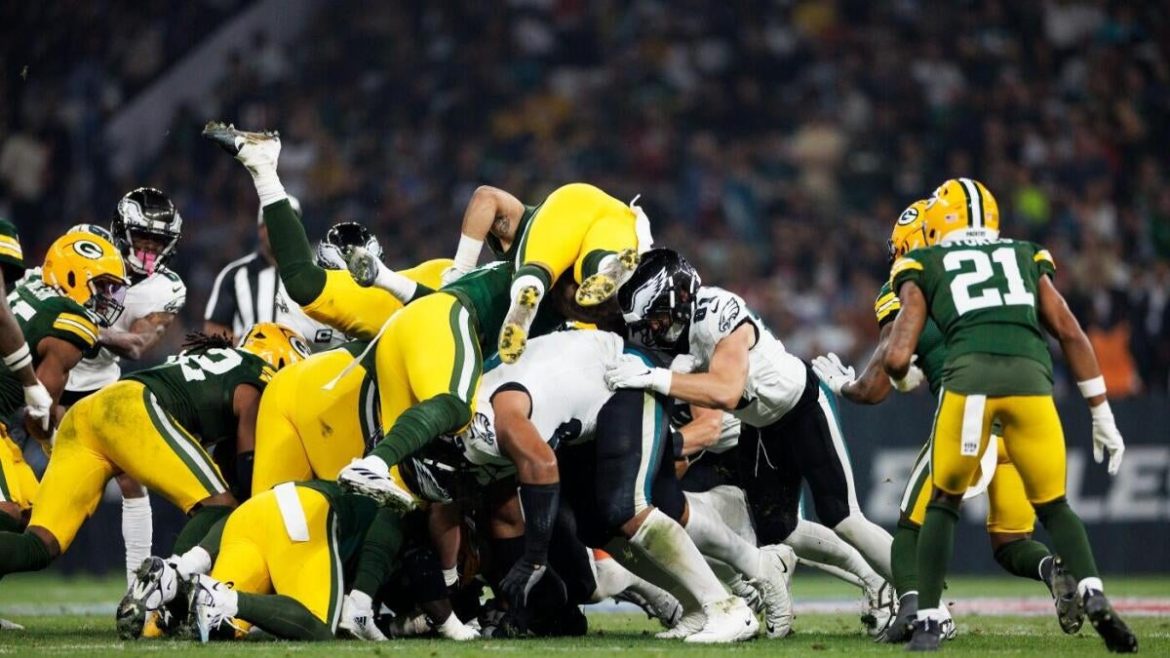Key Takeaways from the 2025 NFL Owners Meetings: The Tush Push, Rule Changes, and Future Directions
The 2025 NFL Owners Meetings held in the Minneapolis area gathered all 32 owners to deliberate crucial rule changes and league policies shaping the upcoming NFL season. Among the most debated topics was the future of the “Tush Push” play, alongside broader discussions on playoff seeding, rule adjustments, and league expansion into new activities like flag football and Olympic participation.
The Tush Push: A Controversial Play Lives On
The “Tush Push” — a trademark quarterback sneak play employed notably by the Philadelphia Eagles — stood at the center of a contentious debate. The proposal to ban this play failed to secure the necessary 24 votes out of 32 owners, effectively upholding its legality for the 2025 season.
This outcome reflects the complex balancing act owners face between preserving strategic innovations and maintaining competitive fairness. Proponents of banning the Tush Push argued it gives an unfair advantage in short-yardage situations and can disrupt defensive integrity. Meanwhile, supporters emphasized its role in exciting gameplay and strategic diversity. Miami Dolphins coach Mike McDaniel and other head coaches voiced opinions on the impact of such plays, underscoring divergent perspectives.
Rule Changes Approved: Enhancing Game Dynamics and Safety
Beyond the Tush Push saga, owners approved several significant rule changes designed to improve gameplay flow and player safety:
– Touchback Spot Adjustment: Owners approved moving the touchback spot to encourage more kickoff returns. The league projects return rates could jump from 32.8% in 2024 to between 60% and 70% in 2025, leading to more dynamic opening plays and potentially more exciting game starts.
– Overtime Modifications: Adjustments to overtime rules aim to create fairness and competitive intensity in late-game situations. These modifications could influence strategic decisions as teams manage end-of-game scenarios.
– Replay Assistance Enhancements: Teams will benefit from fortified replay review protocols, enabling more accurate and quicker officiating decisions, which is critical to maintaining game integrity.
The NFL analytics team played a key role in these discussions by presenting models on how proposed changes would affect gameplay and league competitiveness, especially highlighting an “open seeding” playoff system model advanced by the Detroit Lions. This approach seeks to make late-season games more meaningful by aligning playoff matchups strictly by seeding, rather than division standings, aiming to reward overall records more fairly.
Embracing New Athletic Ventures: Olympic Integration and Flag Football
An unexpected yet forward-looking item on the agenda was the league’s proposal to embrace Olympic participation and add flag football as a league-sanctioned activity. This move signals the NFL’s intent to broaden its reach and engage with a wider, possibly younger audience through less contact-intensive formats of the sport.
Allowing players to participate in Olympic competition and flag football could enhance player visibility during offseasons and introduce alternative pathways for football development and fan engagement, potentially helping the league adapt in changing sports landscapes.
Coaching Perspectives and Leadership Extensions
Amid these organizational deliberations, the Philadelphia Eagles solidified stability by extending head coach Nick Sirianni’s contract. His improbable journey to leading the team to a championship resonated throughout the meeting, showcasing how teams value consistent leadership amid league transitions.
Sirianni’s approach and vision appeared in various interviews and press sessions during the meetings, with insights focused beyond single plays like the Tush Push, highlighting team culture and long-term strategic planning.
Other League-Wide Considerations
– Playoff Seeding Debate: Owners revisited the fairness issue related to division winners receiving home-field advantage despite mediocre records, with proposals aiming to reward teams with better overall performance.
– Player Participation and Safety: Discussions touched on flag football initiatives and damage assessments after recent weather events affecting stadiums, reflecting the league’s intertwined concerns of athlete welfare, infrastructure, and community engagement.
– Offseason Management: The meetings functioned as a nexus between the intense offseason activities—free agency, drafts—and preparing the league framework for the new season, emphasizing ownership collaboration.
—
Conclusion: Navigating Tradition and Innovation in the NFL’s Future
The 2025 NFL Owners Meetings encapsulated the league’s ongoing tension between tradition and innovation. Upholding the Tush Push play preserves a piece of football culture and strategy cherished by some but contentious for others. Meanwhile, embracing rule changes that incentivize offensive excitement (kickoff returns) and fairer playoff structures signals a readiness to evolve amidst competitive and commercial pressures.
By nurturing leadership continuity (e.g., Sirianni’s extension), exploring new athletic arenas like Olympic participation and flag football, and fine-tuning operational rules, the NFL positions itself to balance fan engagement, strategic integrity, and player safety in a rapidly changing sports environment.
As the league embarks on its 2025 season, these decisions reflect a carefully calibrated commitment to growth rooted in respect for the game’s core while adapting to a dynamic future. The outcomes of these meetings will ripple through the season’s playbooks, fan experiences, and ultimately how the sport is embraced by generations to come.





